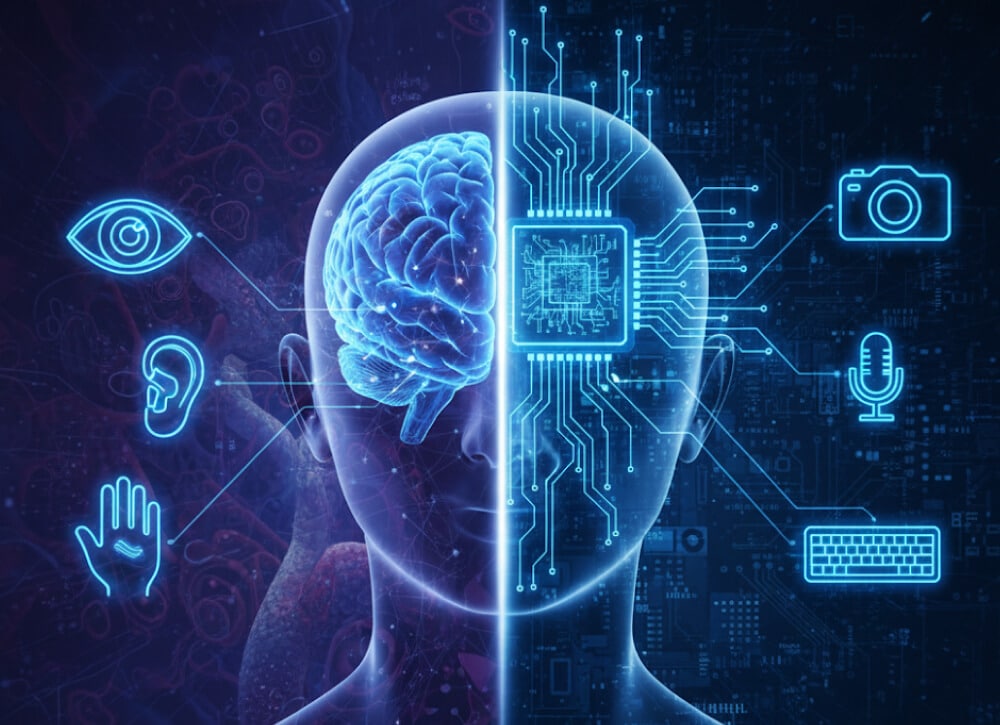How Humans and Machines Recognize the World
Close your eyes and think about how you recognize the smell of coffee, the sound of your best friend’s laugh, or the look of a familiar street. Our brains are constantly decoding sights, sounds, smells, and textures—translating raw sensations into meaningful experiences.
But what if machines could do the same? What if a computer could learn to see, hear, or even understand like we do?
That’s exactly what the field of machine learning and artificial intelligence is attempting. And at its core, the process isn’t as alien as it seems—it’s rooted in the same idea: taking input from the world and finding patterns.
Let’s take a journey from the way humans interpret the world to how machines are learning to do the same.
The Human Way: Sensing, Processing, Learning
Every moment, our senses feed us information:
- Eyes give us shapes, colors, and motion
- Ears detect volume, pitch, and rhythm
- Skin tells us temperature and texture
This raw data is sent to the brain, where it’s processed and matched with memories, emotions, and context. You don’t just hear a sound—you recognize it, react to it, and learn from it.
This is how we recognize patterns. Over time, we become experts at interpreting the world, often without realizing how much we’re learning.
Machines and Their "Senses"
Machines don’t have nerves or emotions, but they do have sensors and data inputs:
- Cameras act like eyes (images and videos)
- Microphones function like ears (audio)
- Text inputs simulate language exposure (books, messages, etc.)
Instead of neurons, they use algorithms. Instead of brains, they use processors. But the job is similar: convert raw input into meaningful output.
Think of a self-driving car:
- Cameras detect objects on the road
- Radar senses distance and speed
- Software processes the signals to decide: stop, go, or turn
Just like how we process what we see and hear to make decisions, machines are doing something very similar.
Finding Patterns in the Noise
When you learn to recognize your favorite song from the first few notes, you’re identifying a pattern. Machine learning does the same.
A machine doesn’t inherently know what a cat looks like or what a happy voice sounds like. But if you feed it enough examples, it begins to learn:
- All cat photos have certain shapes and textures
- Happy voices share certain tones and rhythms
Through repeated exposure, it begins to generalize and make predictions. The same way a child learns that barking often means “dog,” a machine might learn that rounded ears and fur suggest “cat.”
Models: The Machine’s Mind
In machine learning, we build models that mimic perception. These models are trained to:
- Recognize faces in a crowd
- Understand the emotion in a voice
- Translate languages
- Describe objects in images
These tasks require models to move from simple input (pixels, sounds, words) to higher-level understanding—just like our brain does when it converts light into vision or sound into speech.
Machine Perception in Action
If you’ve ever used voice assistants like Siri or Alexa, you’ve interacted with machine perception:
- Your voice is converted into text
- The system interprets your intent
- It responds with information or action
Other examples include:
- Face ID unlocking your phone by recognizing your face
- Search engines showing results based on image queries
- Social media tagging friends automatically in photos
These features are possible because machines are learning to perceive the world, one signal at a time.
Bridging the Gap
Understanding how machines “see” and “hear” isn’t just fascinating—it’s powerful. It shapes:
- Healthcare: AI that reads X-rays and detects disease
- Education: Apps that listen to a child read and provide feedback
- Accessibility: Tools that convert speech to text or describe scenes to visually impaired users
By mimicking the human ability to learn from the senses, machines are becoming more helpful, more intuitive, and more integrated into daily life.
Machines Learn as We Do - One Pattern at a Time
The magic of human learning lies in our ability to make sense of what we see and hear. Machines are now starting to tap into that same magic—not through biology, but through data and patterns.
So the next time your phone unlocks with your face or your playlist gets your mood just right, remember: a machine saw a signal, found a pattern, and recognized your world—just like you would.

